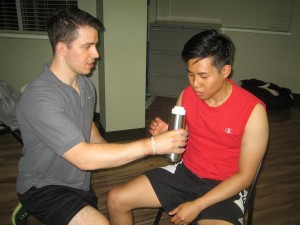Regardless of how fit an individual is, it is important to be aware of the potential dangers when running under the heat, especially if the humidity level is high. Even professional athletes become victims to heat-related disorders if safety precautions are not observed.
How the body handles the heat
The built-in cooling system of the body helps maintain the normal temperature when in a warm environment. The cooling effect is due to the evaporation of the sweat from the surface of the skin. The blood vessels in the skin also dilate to allow increased flow of blood. Once the blood circulates through the interior regions of the body which is called the body core, it steadily heats up. The moment it reaches the blood vessels in the skin, the heat radiates in an outward manner.
Take note that this natural cooling mechanism in the body is not always guaranteed to work. If the individual does not replace the water lost through sweat, dehydration can occur. Once there is not enough water, the sweating mechanism will no longer work effectively.
A warm environment along with high humidity can disrupt the ability of the body to stay cool. Once the humidity is high, there is excess moisture present in the air in which sweat could not evaporate quickly. As a result, the body will lose water as it pumps out sweat while the body temperature continues to rise.
Types of heat-related problems
When overexerting in the heat, the potential problems that can develop include heat cramps, heat exhaustion and heatstroke. Heat cramps are less serious while heatstroke is the most threatening. Take note that the symptoms of these problems overlap and if appropriate first aid care is not provided upon the first sign of heat injury, the condition can progress to its severe form.
Heat cramps
This condition is characterized by painful muscle spasms that occur during or after exercise. These spasms typically occur in the muscles being exercised and can be due to the loss of water and salt through sweating. The body temperature is not elevated. It is important for the individual to rest and replace the lost fluids.
Heat exhaustion

This occurs most often among individuals who are not acclimatized to hot weather which can occur after excessive perspiration accompanied with inadequate intake of water. The symptoms include dizziness, weakness, headache, collapse, cold clammy skin, dilated pupils and a weak, rapid pulse. The individual must be moved to a cool place, allowed to rest and provided with plenty of fluids to drink.
Heatstroke
Heatstroke is considered the most severe heat-related problem and requires immediate medical care. This condition occurs once the body could not eliminate heat fast enough. The cooling system of the body is overwhelmed and eventually breaks down. At this stage, the sweating stops while the circulatory system is strained and the body temperature shoots up to 106 degrees Fahrenheit or more. Immediately transfer the individual to a cool place and place him/her in an ice water bath or cover the body with ice packs until medical treatment can be provided.
